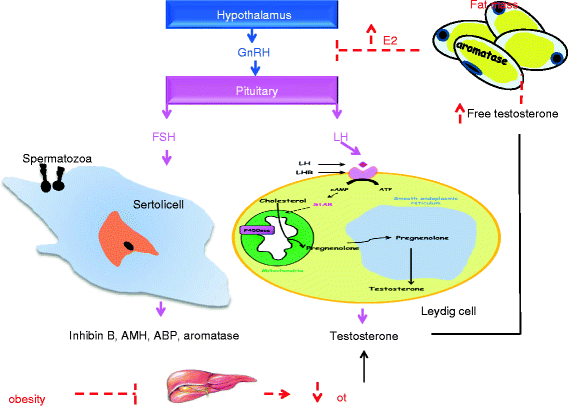Paternal obesity: how bad is it for sperm quality and progeny health?
- PMID: 29123667
- PMCID: PMC5657098
- DOI: 10.1186/s12610-017-0064-9
Paternal obesity: how bad is it for sperm quality and progeny health?
Abstract
There is substantial evidence that paternal obesity is associated not only with an increased incidence of infertility, but also with an increased risk of metabolic disturbance in adult offspring. Apparently, several mechanisms may contribute to the sperm quality alterations associated with paternal obesity, such as physiological/hormonal alterations, oxidative stress, and epigenetic alterations. Along these lines, modifications of hormonal profiles namely reduced androgen levels and elevated estrogen levels, were found associated with lower sperm concentration and seminal volume. Additionally, oxidative stress in testis may induce an increase of the percentage of sperm with DNA fragmentation. The latter, relate to other peculiarities such as alteration of the embryonic development, increased risk of miscarriage, and development of chronic morbidity in the offspring, including childhood cancers. Undoubtedly, epigenetic alterations (ie, DNA methylation, chromatin modifications, and small RNA deregulation) of sperm related to paternal obesity and their consequences on the progeny are poorly understood determinants of paternal obesity-induced transmission. In this review, we summarize and discuss the data available in the literature regarding the biological, physiological, and molecular consequences of paternal obesity on male fertility potential and ultimately progeny health.
De plus en plus de données tendent à montrer que l’obésité paternelle a non seulement des effets néfastes sur la santé métabolique et reproductive de l’individu mais également sur celle de sa descendance. Les mécanismes mis en jeu dans ce processus incluraient des altérations physiologiques et hormonales des fonctions reproductives de l’homme obèse ainsi que des altérations épigénétiques au niveau du génome spermatique. Les modifications hormonales associées à l’obésité et qui se caractérisent principalement par une réduction du taux d’androgènes et une augmentation du niveau d’estrogène induiraient une altération des paramètres spermatiques, une diminution de la concentration ou de la numération totale en spermatozoïde et du volume séminal. Le stress oxydatif dans le testicule induirait une augmentation de la fragmentation de l’ADN spermatique et pourrait rendre compte de l’augmentation des risques de fausses-couches, des problèmes de développement embryonnaire ainsi que de l’augmentation des risques de mortalité chez la descendance, problèmes fréquemment rencontrés lorsque le père est. obèse. Les modifications épigénétiques (altérations des profils de méthylation de l’ADN, de la structure de la chromatine ou/et des profils d’expression des ARN spermatiques) induites par l’obésité sont, quant à elles, loin d’être comprises, même si elles sont, surement, les vecteurs clés de la transmission épigénétique paternelle des maladies métaboliques. L’objet de cette revue est. de résumer puis de discuter les différentes études expérimentales et épidémiologiques publiés à ce jour sur les conséquences physiologiques et moléculaire de l’obésité paternelle sur la santé de l’individu et sur celle de sa descendance.
Keywords: Epigenetics; Fertility; Inheritance; Obesity; Small RNAs.
Conflict of interest statement
Ethics approval and consent to participate
Not applicable.
Competing interests
The authors declare that they have no competing interests.
Publisher’s Note
Springer Nature remains neutral with regard to jurisdictional claims in published maps and institutional affiliations.
Figures


Similar articles
-
Paternal obesity induces changes in sperm chromatin accessibility and has a mild effect on offspring metabolic health.Heliyon. 2024 Jul 5;10(14):e34043. doi: 10.1016/j.heliyon.2024.e34043. eCollection 2024 Jul 30. Heliyon. 2024. PMID: 39100496 Free PMC article.
-
Paternal obesity initiates metabolic disturbances in two generations of mice with incomplete penetrance to the F2 generation and alters the transcriptional profile of testis and sperm microRNA content.FASEB J. 2013 Oct;27(10):4226-43. doi: 10.1096/fj.12-224048. Epub 2013 Jul 11. FASEB J. 2013. PMID: 23845863
-
Role of miRNA in the Transmission of Metabolic Diseases Associated With Paternal Diet-Induced Obesity.Front Genet. 2019 Apr 18;10:337. doi: 10.3389/fgene.2019.00337. eCollection 2019. Front Genet. 2019. PMID: 31057600 Free PMC article. Review.
-
Paternal obesity, interventions, and mechanistic pathways to impaired health in offspring.Ann Nutr Metab. 2014;64(3-4):231-8. doi: 10.1159/000365026. Epub 2014 Oct 2. Ann Nutr Metab. 2014. PMID: 25300265 Review.
-
Oxidation of Sperm DNA and Male Infertility.Antioxidants (Basel). 2021 Jan 12;10(1):97. doi: 10.3390/antiox10010097. Antioxidants (Basel). 2021. PMID: 33445539 Free PMC article. Review.
Cited by
-
Contribution of the seminal microbiome to paternal programming.Biol Reprod. 2024 Aug 15;111(2):242-268. doi: 10.1093/biolre/ioae068. Biol Reprod. 2024. PMID: 38696371 Free PMC article. Review.
-
Iron biomarkers in men with infertility are associated with sperm DNA hydroxymethylation and cumulative live birth rates: a prospective study.J Transl Med. 2025 Aug 5;23(1):861. doi: 10.1186/s12967-025-06777-9. J Transl Med. 2025. PMID: 40764934 Free PMC article.
-
Exposures during the prepuberty period and future offspring's health: evidence from human cohort studies†.Biol Reprod. 2021 Sep 14;105(3):667-680. doi: 10.1093/biolre/ioab158. Biol Reprod. 2021. PMID: 34416759 Free PMC article. Review.
-
Preconceptional paternal obesity may increase the risk of congenital urogenital anomalies in offspring: A case-control study.Andrology. 2025 Jan;13(1):45-54. doi: 10.1111/andr.13673. Epub 2024 Jun 4. Andrology. 2025. PMID: 38837622 Free PMC article.
-
Influence of Risk Factors for Male Infertility on Sperm Protein Composition.Int J Mol Sci. 2021 Dec 6;22(23):13164. doi: 10.3390/ijms222313164. Int J Mol Sci. 2021. PMID: 34884971 Free PMC article. Review.
References
-
- Blundell JE, Cooling J. Routes to obesity: phenotypes, food choices and activity. Br J Nutr. 2000;83(Suppl 1):S33–S38. - PubMed
-
- Proietto J, Baur LA. 10: management of obesity. Med J Aust. 2004;180:474–480. - PubMed
-
- Al-Quwaidhi AJ, Pearce MS, Critchley JA, Sobngwi E, O'Flaherty M. Trends and future projections of the prevalence of adult obesity in Saudi Arabia, 1992–2022. East Mediterr Health J. 2014;20:589–595. - PubMed
LinkOut - more resources
Full Text Sources
Other Literature Sources
Research Materials

